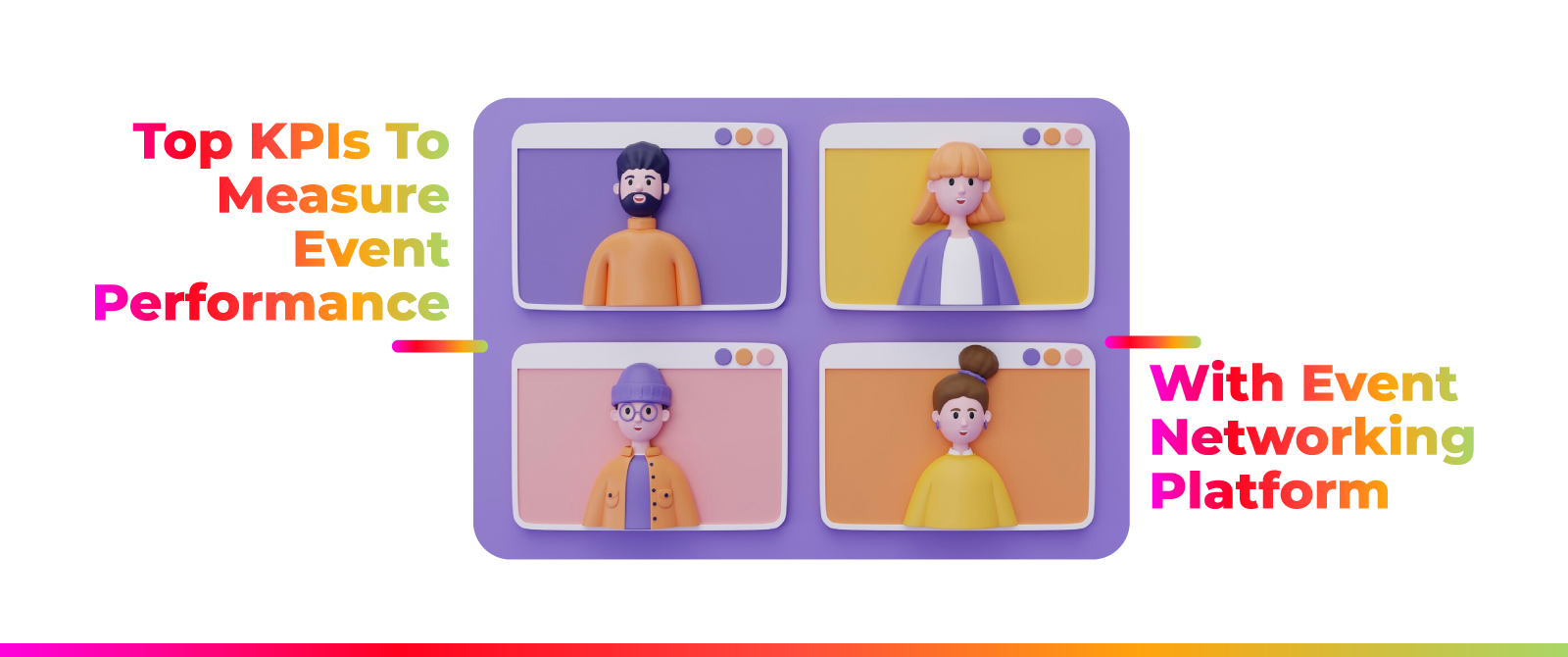Event success is more than just producing a fantastic event—it’s about understanding and maximizing the overall guest experience. Event Networking Software Platforms have become vital tools for event organizers as technology has advanced. It’s critical to focus on Key Performance Indicators (KPIs) that represent the performance of your event networking software platform to guarantee your event is not just a hit but also a measurable success. In this blog article, we’ll look at the key KPIs for monitoring and improving event performance.
Important KPIs for Measuring Networking Event Performance
1. Attendance and Engagement Rates:
Understanding how many registered participants arrive is the first step in ensuring a successful event. The event networking software platform should not only attract a large number of registrants but should also keep participants engaged during the event. Organizers obtain insights into the platform’s capacity to grab and retain participant interest by analyzing the number of registrations vs actual attendance. Measuring attendee engagement is also critical. This entails assessing participant engagement in different event features such as session attendance, chat room discussions, and booth visits. High engagement rates indicate that the event networking software platform is effectively developing connections and actively engaging attendees.
2. User Satisfaction Surveys:
In order to properly evaluate the impact of your event networking apps, you must collect feedback directly from consumers. Post-event surveys may be an effective technique for gauging consumer satisfaction. Organizers may obtain useful data regarding the platform’s capabilities and highlight areas for development by implementing surveys. Analyzing satisfaction ratings and comments offers a qualitative insight into the user experience, enabling targeted improvements in future events.

3. Connection and Interaction Metrics:
The quality of relationships created among participants frequently determines the success of an event. The number of connections made during the event may be used to offer a quantitative assessment of networking success. Beyond only connections, it’s critical to investigate engagement metrics. This involves analyzing messages exchanged, scheduling meetings, and virtual business card exchanges. These metrics provide a more detailed picture of attendee engagement, reflecting the platform’s efficacy in generating meaningful conversations.
4. Lead creation and Conversion Rates:
Lead creation is an important KPI for business-focused events. The event networking apps should be a bountiful source of leads. Organizers can monitor the quantity of leads generated by the platform to analyze its influence on prospective business possibilities. Furthermore, tracking the conversion rates of these leads into real outcomes, such as post-event meetings or partnerships, offers insight into the platform’s effectiveness in converting connections into actionable results.
5. Session Popularity and Content Effectiveness:
Because events frequently include a variety of sessions, assessing the popularity of each session is critical for future planning. Tracking attendance levels for different sessions assists organizers in determining which themes are most popular with the audience. Aside from attendance, gathering comments on sessions gives qualitative data on the content’s efficacy. This data assists event organizers in designing future events to meet the tastes and expectations of attendees.
6. Social Media Reach and Engagement:
In this day and age of digital connectedness, social media plays an important role in extending the reach of events. Monitoring social media mentions, hashtags, and general participation offers information about the online exposure of the event. Using analytics tools, event organizers may assess the influence of social media activity on event success. Understanding the online debate surrounding the event assists in the development of future social media initiatives and the overall promotion of the event.
7. Platform Performance Metrics:
The event networking apps’ technical performance has a direct impact on the user experience. It is critical to monitor platform performance indicators such as page load times, uptime, and user accessibility. A smooth technological experience guarantees that participants can easily traverse the platform, which contributes to overall happiness. It is critical to address any technological difficulties as soon as possible to preserve a great user experience and avoid any interruptions during the event.
8. Return on Investment (ROI):
Ultimately, events need a significant investment, and organizers must assess the profits earned. The Return on Investment (ROI) is calculated by comparing the expenditures of arranging the event to the value created. This value might take the shape of new collaborations, sponsorships, or commercial possibilities. A thorough grasp of the ROI allows event organizers to analyze the overall performance of the event and gives vital information for improving strategies in future events.
9. Networking Quality Metrics:
While number is crucial, so is the quality of networking relationships. Analyze the duration of encounters, the sharing of comprehensive contact information, and the post-event behaviors to determine the depth of relationships. High-quality networking suggests that the event networking software platform such as MindMixer extends beyond superficial connections, assisting participants in developing long-term relationships.
10. Mobile App Adoption:
If you have an event networking app for conferences, tradeshows, or other events, it is critical to track its adoption and usage. Calculate the number of active users, and app engagements. A strong adoption rate suggests that guests like the event networking apps, which improve their entire event experience and provide easy access to networking possibilities while on the road.
11. Metrics for Diversity and Inclusion:
Monitor diversity indicators to assess the inclusiveness of your event. Keep track of attendance demographics, such as industrial sectors, employment responsibilities, and geographic areas. This information assists organizers in assessing the platform’s potential to attract a broad audience and tailoring future events to better match the demands of different participant profiles.
12. Sponsorship interaction:
Evaluate the degree of interaction and visibility sponsors receive through the event networking software platform for events involving sponsors. Metrics like as booth visits, interactions with sponsored material, and the amount of leads produced for sponsors should all be tracked. It is critical to demonstrate value to sponsors in order to secure continuous support and partnerships for future events.
13. Technical Support Response Times:
The timeliness of the technical support staff is critical in the case of technical faults or user concerns. Assess the efficacy of technical assistance offered by monitoring response times to support requests. A timely and effective support system enhances the user experience and reduces disturbances throughout the event.
14. Data Security and Privacy Compliance:
In an era when data security and privacy are becoming increasingly important, verify that your event networking apps conform to current standards. Monitor adherence to data protection rules, log any reported security problems, and communicate openly about data handling methods with participants. A secure and compliant platform fosters confidence among players while protecting sensitive information.
Why Should You Measure Event Performance KPIs
Measuring Event Performance Key Performance Indicators (KPIs) are essential for several reasons, each contributing to the success and growth of your event planning endeavors. Here are the key reasons why measuring event performance KPIs is crucial:
1. Evaluate Success Against Objectives
Measuring event KPIs allows you to assess the success of your event against predefined objectives. Whether your goals were focused on attendee satisfaction, revenue generation, brand awareness, or lead generation, tracking relevant KPIs enables you to determine if you’ve achieved your desired outcomes.
2. Identify Areas for Improvement
By analyzing event KPIs, you gain insights into areas where your event performed well and areas that may require improvement. Whether it’s attendee engagement, session popularity, or sponsor satisfaction, identifying weaknesses allows you to refine your strategies and processes for future events.
3. Demonstrate ROI to Stakeholders
For sponsors, exhibitors, and other stakeholders, measuring event KPIs provides tangible evidence of the return on investment (ROI) they received from participating in your event. Demonstrating the value they gained in terms of brand exposure, leads generated, or business opportunities created strengthens relationships and encourages continued support for future events.
4. Enhance Attendee Experience
Measuring attendee satisfaction KPIs, such as Net Promoter Score (NPS), attendee feedback, or post-event surveys, enables you to understand the attendee experience and identify opportunities for improvement in NPS calculation. Addressing pain points and implementing changes based on feedback helps enhance the overall attendee experience and fosters loyalty among attendees.
5. Track Trends and Patterns
Analyzing event KPIs over time allows you to track trends and patterns in attendee behavior, preferences, and engagement. Understanding these trends enables you to anticipate future needs, tailor your event offerings to meet attendee expectations, and stay ahead of evolving industry trends.
6. Support Data-Driven Decision Making
Measuring event KPIs provides valuable data that can inform decision-making processes across all aspects of event planning and management. Whether it’s selecting event venues, choosing speakers, or developing marketing strategies, data-driven insights empower you to make informed decisions that drive success.
Final Words:-
Event organizers may receive significant insights into the efficacy of their event networking software platform by proactively monitoring these KPIs. This data-driven strategy not only assures the current event’s success but also informs future decision-making, allowing organizers to continuously improve the guest experience and give excellent value. As technology evolves, remaining watchful with these KPIs will be critical to realizing the full potential of your events.
FAQs
KPIs, or Key Performance Indicators, are quantitative indicators that aid in determining the achievement of certain goals. KPIs give significant information into different elements of events and event networking platforms, such as attendance, engagement, and ROI.
The selection of KPIs is determined by the aims and objectives of your event. Consider the event’s type, intended audience, and desired objectives. Attendance rates, networking, engagement metrics, lead generation, and ROI are all common KPIs. Making your KPI choices unique to your event objectives delivers valuable information.
User happiness is critical to an event’s overall success. It is measured by implementing post-event questionnaires to collect feedback on the event networking platform. Satisfaction ratings and comments give qualitative insights into the user experience, assisting organizers in identifying areas of strength and opportunity.
Yes, the quality of networking relationships is as crucial as the quantity. Metrics for assessing networking quality include the duration of interactions, the sharing of specific contact information, and post-event follow-up actions. The presence of high-quality networking suggests that the event platform supports significant and long-term connections.






